Related Research Articles

Kinshasa, formerly named Léopoldville before June 30, 1966, is the capital and largest city of the Democratic Republic of the Congo. Once a site of fishing and trading villages along the Congo River, Kinshasa is now one of the world's fastest-growing megacities. With an estimated population of 16 million residents, it's the most densely populated city in the DRC and the most populous city in Africa. It is Africa's third-largest metropolitan area and the leading economic, political, and cultural center of the DRC. Kinshasa houses several industries, including manufacturing, telecommunications, banking, and entertainment. The city also hosts some of DRC's significant institutional buildings, such as the Palais du Peuple, Palais de la Nation, Court of Cassation, Constitutional Court, Cité de l'Union Africaine, Palais de Marbre, Stade des Martyrs, Immeuble du Gouvernement, Kinshasa Financial Center, and multiple federal departments and agencies.

Lingala (Ngala) is a tonal Bantu language spoken in the northwest of the Democratic Republic of the Congo, the northern half of the Republic of the Congo, in their capitals, Kinshasa and Brazzaville, and to a lesser degree in Angola, the Central African Republic, Kenya and southern South Sudan. Lingala has 25–30 million native speakers and about 35 million second-language speakers, for an approximate total of 60–65 million speakers.

The Democratic Republic of the Congo, also known as Congo-Kinshasa, DRC, DR Congo, or simply the Congo and known from 1971–1997 as Zaire, is a country in Central Africa. By land area, the DRC is the second-largest country in Africa and the 11th-largest in the world. With a population of around 112 million, the Democratic Republic of the Congo is the most populous officially Francophone country in the world. The national capital and largest city is Kinshasa, which is also the economic center. The country is bordered by the Republic of the Congo, Central African Republic, South Sudan, Uganda, Rwanda, Burundi, Tanzania, Zambia, Angola, the Cabinda exclave of Angola and the South Atlantic Ocean.

Congolese music is one of the most influential music forms of the African continent. Since the 1930s, Congolese musicians have had a huge impact on the African musical scene and elsewhere. Many contemporary genres of music, such as Kenyan Benga and Colombian Champeta, have been heavily influenced by Congolese music. In 2021, Congolese rumba joined other living traditions such as Jamaican reggae music and Cuban rumba on UNESCO's "intangible cultural heritage of humanity" list.

Bandundu is one of eleven former provinces of the Democratic Republic of the Congo. It bordered the provinces of Kinshasa and Bas-Congo to the west, Équateur to the north, and Kasai-Occidental to the east. The provincial capital is also called Bandundu.

Soukous is a genre of dance music originating from the Democratic Republic of the Congo and the Republic of the Congo. It derived from Congolese rumba in the 1960s, with faster dance rhythms and bright, intricate guitar improvisation, and gained popularity in the 1980s in France. Although often used by journalists as a synonym for Congolese rumba, both the music and dance associated with soukous differ from more traditional rumba, especially in its higher tempo, song structures and longer dance sequences.
African popular music, like African traditional music, is vast and varied. Most contemporary genres of African popular music build on cross-pollination with Western popular music. Many genres of popular music like blues, jazz, salsa, zouk, and rumba derive to varying degrees on musical traditions from Africa, taken to the Americas by enslaved Africans. These rhythms and sounds have subsequently been adapted by newer genres like rock, and rhythm and blues. Likewise, African popular music has adopted elements, particularly the musical instruments and recording studio techniques of the Western music industry. The term does not refer to a specific style or sound but is used as a general term for African popular music.

The culture of the Democratic Republic of the Congo is extremely varied, reflecting the great diversity and different customs which exist in the country. Congolese culture combines the influence of tradition to the region, but also combines influences from abroad which arrived during the era of colonization and continue to have a strong influence, without destroying the individuality of many tribal customs.

Ndombolo, also known as dombolo, is a genre of dance music originating in the Democratic Republic of the Congo. Derived from soukous in the 1990s, with fast-paced hip-swaying dance rhythms, often accompanied by upbeat, percussion-driven music, the style became widespread in the mid-1990s and the subsequent decade, dominating dancefloors in central, eastern, and western Africa. It inspired West African popular music, coupé-décalé, Kuduro, and East African dance music.
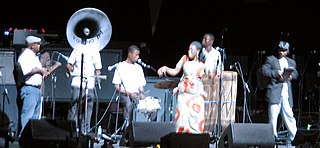
Konono Nº1 is a musical group from Kinshasa, Democratic Republic of the Congo. They are known for their DIY aesthetic, combining electric likembé with vocals, dancers, and percussion instruments that are made out of items salvaged from a junkyard. The group's amplification equipment is equally rudimentary, including a microphone carved out of wood fitted with a magnet from an automobile alternator and a gigantic horn-shaped amplifier. The genre of the band's music has been characterized as difficult to classify; the group themselves have classified their music under the labels of "tradi-modern" and "Congotronics".
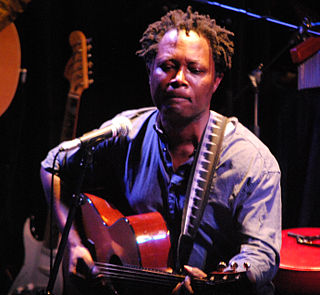
Pascal Lokua Kanza, known professionally as Lokua Kanza, is a Congolese singer, songwriter, arranger, producer, and multi-instrumentalist. He is known for his soulful, folksy sound, which is atypical of the dancefloor-friendly soukous music that is common in Democratic Republic of the Congo. His proficiency in blending different musical styles and cultural influences has made him a celebrated artist, admired for his distinctive and evocative musical creations. He sings in French, Swahili, Lingala, Portuguese, and English. He was a coach in The Voice Afrique Francophone in 2016 and 2017.
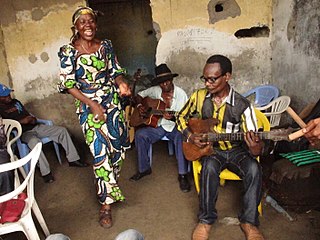
Congolese rumba, also known as African rumba, is a dance music genre originating from the Democratic Republic of the Congo and the Republic of the Congo. With its rhythms, melodies, and lyrics, Congolese rumba has gained global recognition and remains an integral part of African music heritage. In December 2021, it was added to the UNESCO list of intangible cultural heritage.
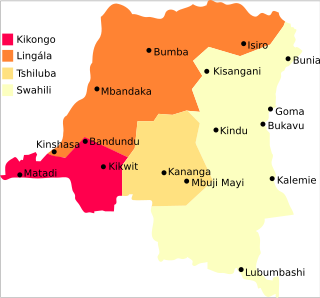
The Democratic Republic of the Congo is a multilingual country where an estimated total of 242 languages are spoken. Ethnologue lists 215 living languages. The official language, since the colonial period, is French, one of the languages of Belgium. Four other languages, three of them Bantu based, have the status of national language: Kikongo, Lingala, Swahili and Tshiluba.

Antoine Wendo Kolosoy, known as Papa Wendo, was a Congolese musician. He is considered the "doyen" of Congolese rumba, a musical style blending traditional Kongolese rhythm and son cubano.

Staff Benda Bilili are a group of street musicians in the Democratic Republic of the Congo. They used to live around the grounds of the zoo in the country's capital city, Kinshasa, and play music which is rooted in soukous, with elements of old-school rhythm and blues and reggae. The core of the band consists of four senior singers/guitarists, who are paraplegic and move around in spectacularly customized tricycles. They are backed by a younger rhythm section consisting of abandoned street children who were taken under the protection of the older members of the band. The soloist is an 18-year-old boy (2009) who plays guitar-like solos on an electrified one-stringed lute he designed and built himself out of a tin can. The group's name translates roughly from Lingala as "look beyond appearances".
Jossart N'Yoka Longo is a Congolese singer, songwriter and producer. After starting his career within Bel Guide National in 1967, he became the third member, after Papa Wemba and Félix Manuaku Waku, of the legendary group Zaïko Langa Langa, of which he later established himself as the main leader.
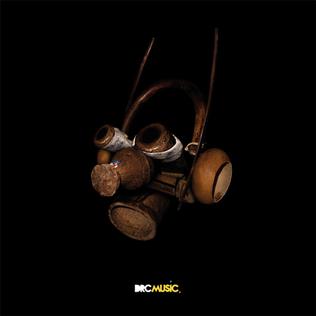
Kinshasa One Two is an album recorded by Damon Albarn alongside ten producers of the newly established DRC Music group, to benefit Oxfam's work in Congo.

Fally Ipupa N'simba, known professionally as Fally Ipupa, is a Congolese singer-songwriter, dancer, philanthropist, guitarist, and producer. Often referred to as the "Prince of Rumba", he is noted for his soulful and mellow tenor vocals, as well as his blend of contemporary and traditional Congolese music genres, including Congolese rumba, soukous, and ndombolo. His lyrics often encapsulate universal themes of romance, suffering, and joy.
The following is a timeline of the history of the city of Kinshasa, Democratic Republic of the Congo.

Fongola is the debut album of Congolese experimental electronic pop musical group KOKOKO!, released 5 July 2019 by Transgressive Records. The album is made with a combination of instruments made from junk and electronic instruments.
References
- 1 2 3 4 5 Boilen, Bob (15 November 2019). "KOKOKO!: Tiny Desk Concert". NPR. Archived from the original on 4 May 2021. Retrieved 7 July 2021.
- 1 2 3 4 Sarmiento, Isabella Gomez (19 October 2019). "Congo's KOKOKO! Makes Joyful Dance Music From Instruments Made Of Junk". NPR. Archived from the original on 16 April 2021. Retrieved 7 July 2021.
- 1 2 Kalia, Ammar (11 July 2019). "Kokoko!: Fongola review – commanding percussive DIY from DRC innovators". The Guardian . Archived from the original on 29 November 2020. Retrieved 7 July 2021.
- 1 2 Solomon, Feliz (4 May 2017). "KOKOKO! Are a Congolese Band That Make Music From Electronic Junk. You Have to See Their Incredible Video". Time. Archived from the original on 11 April 2021. Retrieved 7 July 2021.
- ↑ Domanick, Andrea (10 October 2019). "Can Electronic Music Be Made With Metal Cans and Car Parts? Kokoko! Says Yes: Interview". Billboard. Archived from the original on 18 September 2020. Retrieved 7 July 2021.
- 1 2 Fraden, Angel E. (15 January 2018). "KOKOKO! Is the Raw, Alternative Sound of Kinshasa". OkayAfrica. Archived from the original on 27 February 2021. Retrieved 7 July 2021.
- ↑ Hird, Alison (18 January 2018). "Kokoko! alternative dance music crafted in Kinshasa". RFI. Archived from the original on 3 December 2020. Retrieved 7 July 2021.
- ↑ Domanick, Andrea (21 August 2019). "Kokoko!'s 'Buka Dansa' Is an Analog Electronic Jam Fresh From the Congo: Exclusive". Billboard. Archived from the original on 8 November 2020. Retrieved 7 July 2021.
- ↑ Taylor, Chris. "KOKOKO! - Fongola". DIY. Archived from the original on 12 December 2019. Retrieved 7 July 2021.
- 1 2 3 4 5 6 7 8 9 "KOKOKO!". Discogs. Archived from the original on 18 February 2021. Retrieved 4 July 2021.